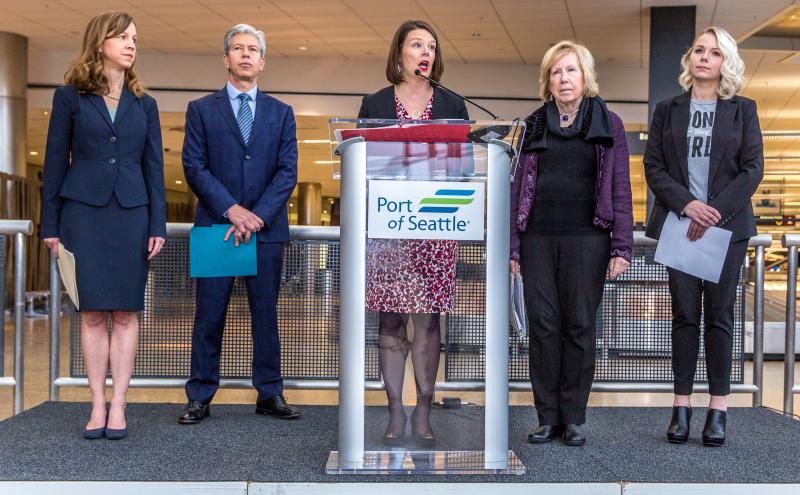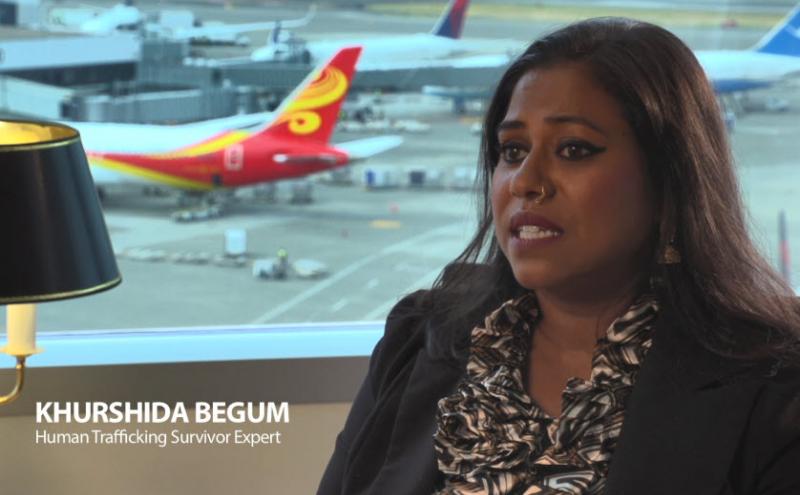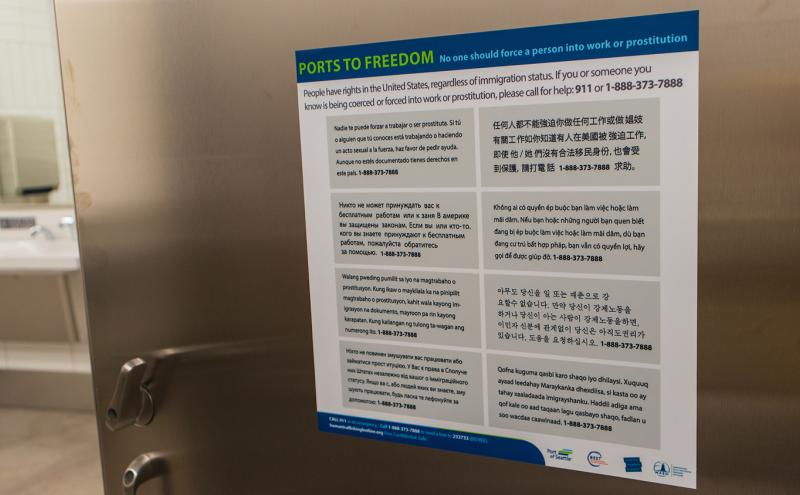
Human trafficking is happening in our state and our public spaces every day. Statistics from the National Human Trafficking Hotline show that 955 signals (reports) were received in Washington state in 2021. Of those signals, 404 were from victims or survivors of human trafficking. Additionally, 233 cases involving 337 victims of trafficking were identified in the state.
Because transportation hubs like airports are often used to transport victims, the Port of Seattle has been a regional leader in anti-human trafficking awareness efforts since 2018. Surveys of trafficking victims indicated that 38% traveled by plane at some point during their exploitation, 63% reported using mass transit during their exploitation, and 26% reported that public and mass transportation played a role in at least one exit attempt.
Recent history
First, a short history of the Port’s fight against human trafficking.
2018: Campaign launch
The Port of Seattle installed 310 signs in the restrooms and passenger loading bridges at Seattle-Tacoma International Airport, as well as 20 signs at Port of Seattle parks and 10 signs at Fishermen’s Terminal. Signage in eight languages beyond English was developed, including Spanish, Tagalog, Korean, Chinese, Somali, Russian, Ukrainian, and Vietnamese.
The Port collaborates with nonprofits, state, and federal agencies, and key customers and vendors like airlines, airport dining and retail, taxis and TNCs, ocean carriers, intermodal transportation providers, and construction contractors.
The Port partnered with Business Ending Slavery and Trafficking (BEST), a Seattle-based nonprofit, to create two online human trafficking prevention courses. Courses were developed specifically for the maritime and aviation industries. And the Port Police Department developed its own law enforcement-specific training plan.
January 2019: Increased awareness and reporting
This year, the campaign broadened to include government and private partners throughout the region. Leaders representing King County, Port of Seattle, City of Seattle, Sound Transit, Alaska Airlines, and Delta Air Lines launched a unified public awareness campaign to stop human trafficking, encouraging survivors to call a national hotline for assistance. Signs rolled out at airports, health clinics, libraries, community centers and law enforcement and public defender officers. And were prominently placed on buses and trains and in restroom stalls.
Heightened awareness in the community resulted in more reports to the National Human Trafficking Hotline, with Washington rising from thirteenth highest in 2018 to the eighth highest call volume in 2019.
Read about the regional approach
2020
The Port implemented a requirement to train 100% of Port staff on human trafficking, how to spot it, and what to do.
The Port of Seattle also provided BEST with a $100,000 grant to serve human trafficking survivors and at-risk youth living in the near-airport communities of Burien, Des Moines, Federal Way, Normandy Park, SeaTac, and Tukwila.
2021: Expanding training to the maritime community
Anti-trafficking group Polaris released stats showing that the number of human trafficking cases handled by the National Human Trafficking Hotline increased 40 percent during the pandemic.
Commissioner Sam Cho joined partners at BEST and the Washington Attorney General’s Office to raise awareness with seaport leaders and the maritime industry.
The training program, with revised signage, was expanded to maritime workers and SEA Airport workers that were not Port employees. This was an opportunity to encourage seaport leaders to participate and raise awareness in the maritime industry.
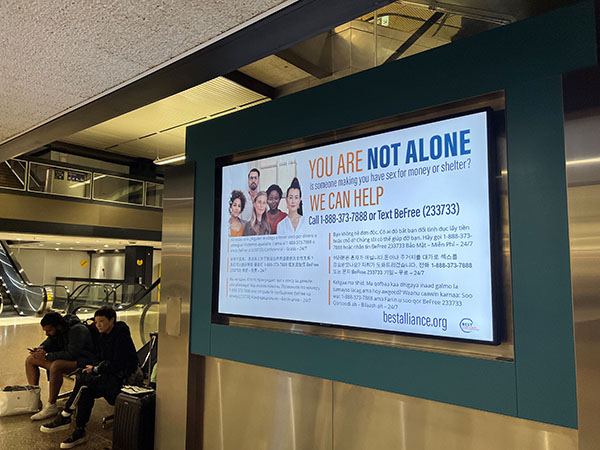
2022: Survivors self-identify
In collaboration with BEST and several municipalities across Washington state, the Port launched the Not Alone campaign in SEA Airport and Port facilities. This campaign is one of the first campaigns to focus on victim and survivor self-identification rather than general public awareness.
Multi-lingual signage was displayed by 26 partner organizations in in English, Spanish, Russian, Chinese (Mandarin), Korean, Vietnamese, and Somali throughout the state, including transit facilities, buses, terminals, restrooms, airport and seaport facilities, and buildings serving vulnerable populations.
The Port’s efforts focused on
- training employees,
- utilizing its facilities and communication channels to raise public awareness of human trafficking, providing information to stop trafficking taking place at our facilities,
- updating internal policies
- partnerships with vendors like airlines, airport dining and retail, taxis and TNCs, ocean carriers, intermodal transportation providers and construction contractors
Learn more:
- Washington launches first ever statewide anti-human trafficking campaign
- Port expands efforts to combat human trafficking
2023: Pledge to fight human trafficking
During National Slavery and Human Trafficking Prevention Month (January 2023), the Port is launching the Port Allies Against Human Trafficking (PAAHT) pledge and calling on its partners and tenants to raise awareness of the signs and behaviors of human trafficking with their employees.
Organizations that sign the pledge are joining the fight against human trafficking by:
- Endorsing and amplifying Port-led public education campaigns on human trafficking at and around all Port facilities
- Building staff familiarity with typical trafficking signs and behaviors
- Reinforcing guidance on how to report suspected occurrences of human trafficking at Port facilities
- Port leaders sign pledge against human trafficking
The Port will make training materials available in multiple formats to workers at Port facilities, community-based organizations, and survivors of trafficking and is designing a campaign to ensure airport workers and the public are aware of how to help fight human trafficking.
Lessons learned
1. Learn from survivors’ lived experiences
The first step is learning from and listening to survivors of human trafficking about their experiences. To do this, the Port partnered with Businesses Ending Slavery and Trafficking (BEST) to train Port and SEA Airport employees on what human trafficking is, the signs of trafficking, and how to safely respond and prevent trafficking from occurring.
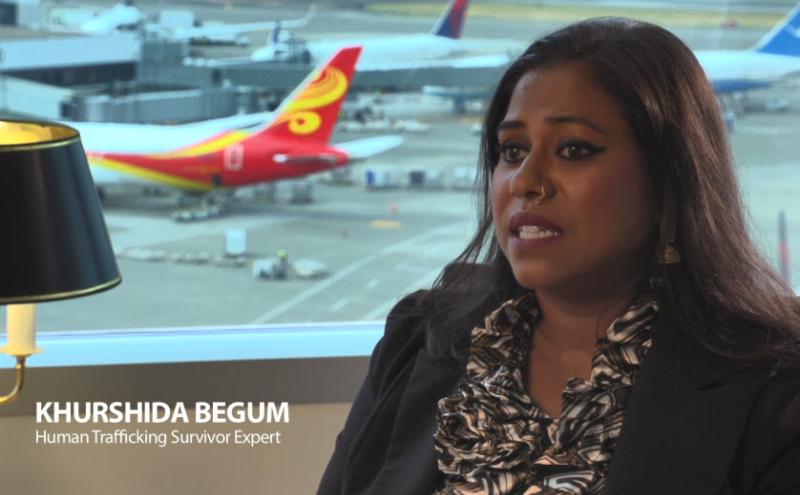
Hearing stories directly from trafficking survivors is one of the most effective and compelling ways to raise awareness. Take the story of Khurshida Begum, who was seven years old when she was abducted from her village in Bangladesh. With eight other children ranging from ages three to 17, she traveled through an airport to a farm community in Southeast Washington. The children were held captive and forced to do agricultural labor from sunup to sundown, were beaten and starved, and were not paid for their work.
Watch a video of Kurshida telling her story (age-restricted video courtesy of Inside Outside)
The Port is growing opportunities to learn from lived experiences through planned open space events at various facilities in 2023.
2. Increase awareness
The more eyes watching for human trafficking, the more awareness and reports of suspected trafficking and survivor calls to the National Human Trafficking Hotline. That’s why every Port of Seattle and SEA Airport employee and other government employees around the region have received training on the signs of trafficking and what to do if they suspect human trafficking is occurring. To date, the Port has trained more than 2,000 employees on human trafficking and what to do about it.
3. Regional collaboration is essential
The 2021 program demonstrated the effectiveness of collaborating with nonprofits, state and federal agencies, and key customers and vendors like airlines, airport restaurants and shops, taxis and TNCs, ocean carriers, intermodal transportation providers, and construction contractors. For this reason, the Port is urging all its partners to join forces and take the pledge to combat human trafficking and receive training materials.
4. Provide clear direction on what to do
Once employees and frontline staff are aware of what’s happening, it’s important to provide clear and unified direction on what to do about it.
Employees who think they are witnessing human trafficking should call 911 so the situation can get addressed immediately
People who are being trafficked should call
- 911 for immediate help
- Then the National Human Trafficking Hotline at 1-888-373-7888
How you can help
1. Educate yourself
- Read stats about human trafficking in Washington
- Learn more about human trafficking, the signs that someone is being trafficked, and what you can do
2. Build awareness in your community
Educate your friends and family about human trafficking and how to help stop it.
- Take a training yourself or facilitate a discussion at work
- Download awareness materials from the National Human Trafficking Hotline
3. See something, say something
- Bystanders who think they are seeing human trafficking that can be intercepted in the moment should call 911
- To learn more or report suspicions that are less time-sensitive call the National Human Trafficking Hotline at 1-888-373-7888
- How to help if you think you see a person being trafficked

